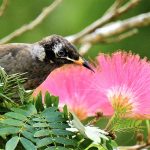BRIDLED HONEYEATER
The Bridled Honeyeater is a striking bird with a distinctive appearance. It measures about 20 to 25 centimetres in length. Its plumage is mostly olive-green, but what truly sets it apart is the unique white “bridle” pattern across its face, which gives the bird its name. This pattern includes a white line running from the beak, encircling the eye, and extending down the neck. Its crown is a dark olive colour, and it has a slightly curved bill, perfect for sipping nectar.
The Bridled Honeyeater is primarily found in the tropical rainforests of north-eastern Queensland, Australia. Its range extends from the Atherton Tablelands to the coastal lowlands. These birds prefer the lush, dense foliage of rainforests, where they can find plenty of food and shelter. Despite their preference for dense rainforests, Bridled Honeyeaters can sometimes be found in more open woodlands and even gardens, showcasing their adaptability.
Breeding season for the Bridled Honeyeater typically occurs from September to January, coinciding with the wet season when food is abundant. They build cup-shaped nests high in trees, usually made from bark, leaves, and spider webs. The female lays two to three eggs, which she incubates while the male provides food. Both parents are involved in feeding the chicks once they hatch.
As honeyeaters, these birds primarily feed on nectar, which they extract with their specialised brush-tipped tongues. They are often seen flitting around flowering trees, such as eucalyptus and banksias. In addition to nectar, they also consume insects and fruits, which provide essential proteins and nutrients. Bridled Honeyeaters play a crucial role as pollinators in their ecosystem. As they feed on nectar, they inadvertently transfer pollen from flower to flower, aiding in plant reproduction.
These birds are known to be quite social, often seen in small flocks, especially outside the breeding season. This social structure helps them protect each other from predators.
While exact data on their lifespan in the wild is scarce, honeyeaters generally live for about 5 to 10 years. Their survival depends heavily on the availability of food and suitable habitat.
The call of the Bridled Honeyeater is a series of sharp, melodious notes that can be quite loud and distinctive. Their vocalisations are an essential part of their behaviour, used for communication between mates and signalling territory boundaries.
While the Bridled Honeyeater is currently not considered threatened, habitat destruction and climate change pose potential risks. Protecting their rainforest habitat is vital for their continued survival.
Through understanding and appreciating the Bridled Honeyeater, we can be inspired to contribute to the conservation of these beautiful birds and their lush rainforest homes.





